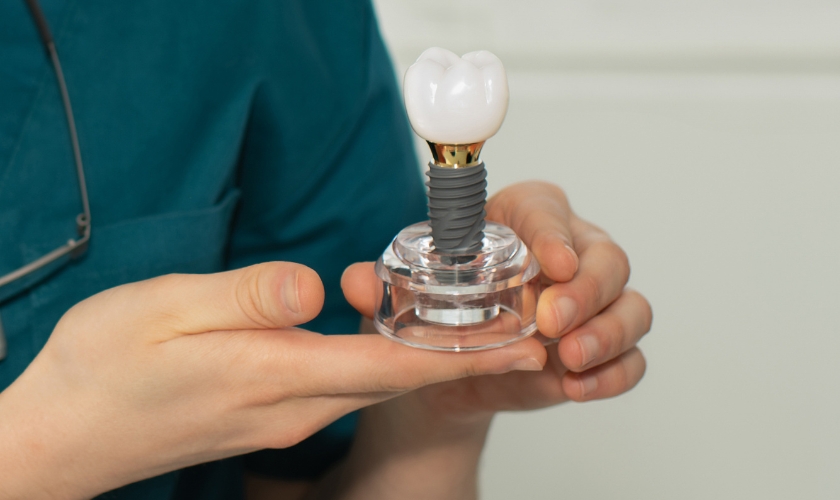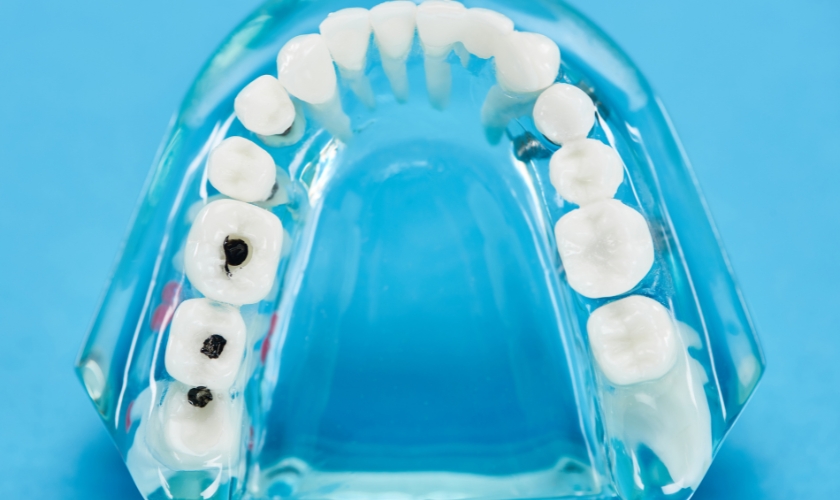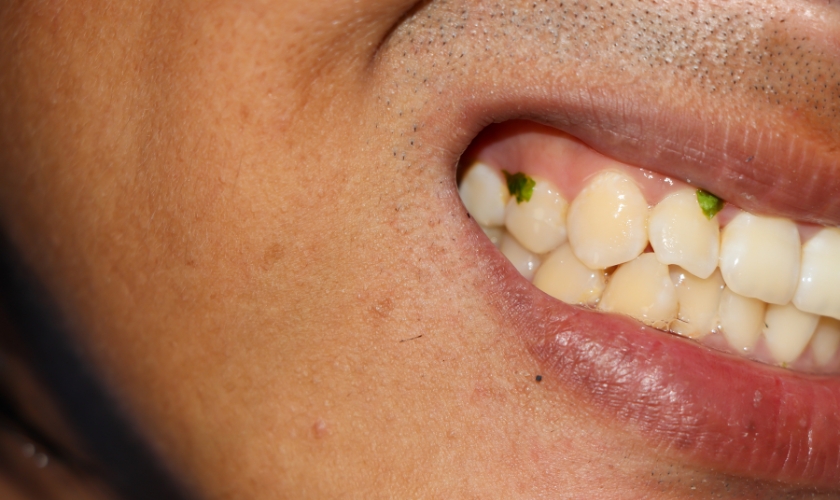
By Gentle Touch Dentistry Richardson
Dental implants are a popular and long-lasting solution for replacing missing teeth. They offer numerous benefits over traditional bridges and dentures, including improved function, stability, and aesthetics. But how do dental implants affect the gums? Let’s delve into the world of dental implants and understand their relationship with gum tissue.
Function and Placement of Dental Implants
A dental implant is a small, screw-like post typically made of titanium. This post is surgically placed into the jawbone, where it fuses with the bone over time through a process called osseointegration. This creates a strong foundation for an artificial tooth, called a crown, which is then attached to the implant post.
During the implant placement procedure, a small incision is made in the gum tissue to access the jawbone. Once the implant is positioned, the gum tissue is stitched closed to allow for healing.
The Healing Process: Gums and Implant Integration
Following implant placement, the gums play a crucial role in the healing process. Here’s what happens:
Initial Healing: In the first few weeks after surgery, the gums heal around the implant site. Blood clots form, and new tissue begins to grow.
Osseointegration: Over a period of several months (usually 3-6 months for the lower jaw and 4-8 months for the upper jaw), the implant fuses with the jawbone. During this time, the gums continue to heal and form a tight seal around the implant.
Healthy gum tissue is essential for successful osseointegration and long-term implant stability.
Do Gums Naturally Grow Around Implants?
The good news is that yes, gums naturally grow back around dental implants during the healing process. After the implant is placed, the gum tissue stitches will dissolve, and the gums will gradually heal and reattach to the implant surface. This creates a tight seal that helps prevent bacteria from entering the implant site and causing infection.
It’s important to note that healthy gums are crucial for this natural regrowth. Maintaining proper oral hygiene practices like brushing and flossing is essential for optimal healing and preventing gum problems around implants
Understanding Gum Recession: Causes and Risks After Implants
While gums naturally grow back around implants, a condition called gum recession can sometimes occur. Let’s explore what gum recession is, its causes, and the specific risks associated with dental implants in Richardson, TX.
What is Gum Recession and How Does it Happen?
Gum recession is the gradual wearing away of gum tissue, exposing more of the tooth root surface. This can happen for various reasons, including:
Poor oral hygiene: Plaque buildup due to inadequate brushing and flossing can irritate the gums, leading to inflammation and recession.
Gum disease: Gingivitis (early gum disease) and periodontitis (advanced gum disease) can destroy gum tissue and bone around teeth.
Aggressive brushing: Brushing too hard can damage gum tissue over time.
Hormonal changes: Pregnancy and menopause can make gums more susceptible to inflammation and recession.
Genetics: Some people are naturally predisposed to having thinner or weaker gum tissue.
Risk Factors for Gum Recession with Implants
While gum recession can affect anyone, certain factors increase the risk after dental implant placement:
Poor Implant Placement: If the implant is positioned too close to the gum surface, it can put excess pressure on the gum tissue, leading to recession.
Insufficient Jawbone Density: If the jawbone is not strong enough to support the implant adequately, it can lead to bone loss, which often coincides with gum recession.
Poor Oral Hygiene: Just like with natural teeth, neglecting proper oral hygiene practices can significantly increase the risk of gum recession around implants.
Bruxism: The constant clenching and grinding of teeth can put excessive pressure on the implants and surrounding bone and gum tissue, contributing to recession.
Maintaining Healthy Gums Around Implants: Essential Practices
Having healthy gums is paramount for the success and longevity of your dental implants. Here are some essential practices to keep your gums happy and healthy:
Brushing and Flossing Techniques for Implants
Brushing and flossing are crucial for removing plaque and bacteria buildup around implants, just like with natural teeth. However, some slight modifications to your technique are necessary to avoid damaging the implant or surrounding tissue.
Brushing: Use a soft-bristled toothbrush and gentle brushing motions. Focus on cleaning the implant surface, the gum line, and the space between the implant and surrounding teeth. Angled brushes specifically designed for implants can be helpful.
Flossing: Use soft dental floss or a floss threader specifically designed for implants. Gently guide the floss between the implant and neighboring teeth, cleaning both sides of the implant surface.
Brushing twice a day and flossing once a day are recommended minimums, but some dentists in Richardson might suggest more frequent cleaning depending on your individual needs.
Using the Right Dental Products for Implants
Choosing the right dental hygiene products can make a big difference in maintaining healthy gums around implants. Look for:
Soft-bristled toothbrush: This helps prevent abrasion of the implant surface and gum tissue.
Fluoride toothpaste: Fluoride strengthens tooth enamel and helps fight cavities, which can also affect implant health.
Antiseptic mouthwash: An antiseptic mouthwash can help reduce plaque and bacteria buildup around implants.
Interdental brushes: These small brushes can effectively clean between implants and surrounding teeth, where traditional floss might not reach.
Consult your Richardson dentist for personalized recommendations on the best oral hygiene products for your specific needs and implant type.
Regular Dental Checkups and Professional Cleanings
Regular dental checkups and professional cleanings are vital for maintaining healthy gums around implants. During these visits, your dentist in Richardson will:
- Examine your gums and implants for signs of recession or infection.
- Remove plaque and tartar buildup that you can’t remove at home.
- Monitor the health of your jawbone.
- Offer personalized advice on maintaining optimal oral hygiene.
The frequency of dental checkups and cleanings may vary depending on your individual risk factors and overall oral health. However, most dentists recommend scheduling them at least twice a year.
Treatment Options for Existing Gum Recession Around Implants
Even with the best preventive measures, gum recession around implants can sometimes occur. If you notice signs of gum recession, such as an exposed implant surface, increased sensitivity, or receding gum line, it’s crucial to see your dentist near Richardson promptly. Early intervention is key to preventing further complications.
When to Consider Treatment for Gum Recession
Here are some signs that might indicate the need for treatment for gum recession around implants:
- Visible exposure of the metal implant post.
- Increased sensitivity around the implant, especially to cold or hot temperatures.
- Receding gum line, making the implant appear longer.
- Bleeding or persistent inflammation around the implant.
- Loose feeling of the implant.
If you experience any of these symptoms, don’t hesitate to schedule an appointment with your dentist in Richardson to discuss treatment options.
Non-Surgical Treatments: Scaling and Root Planing
In some cases, if the gum recession is mild, non-surgical treatments like scaling and root planing might be sufficient.
Scaling: This procedure removes plaque and tartar buildup from the implant surface and surrounding teeth.
Root Planing: This process smoothens the rough surfaces of the implant and teeth roots, making it harder for plaque to adhere in the future.
Scaling and root planing can help control gum inflammation and potentially promote some gum tissue regeneration in mild recession cases.
Surgical Gum Grafting Techniques
For moderate to severe gum recession, surgical gum grafting procedures might be necessary. These procedures aim to rebuild lost gum tissue and cover the exposed implant surface. Here are some common gum grafting techniques used for implants:
1. Connective Tissue Graft: This technique involves taking a small piece of tissue from the roof of your mouth (palate) and transplanting it to the area around the implant to reinforce the gum tissue.
2. Free Gingival Graft: Similar to the connective tissue graft, this procedure uses a small piece of gum tissue harvested from another area of your mouth and transplanted to the implant site.
3. Pedicle Graft: In this technique, a flap of gum tissue is taken from adjacent healthy gum tissue and rotated to cover the exposed implant surface. This option minimizes the need for a separate donor site.
The specific type of gum grafting procedure recommended by your Richardson dentist will depend on the severity of the recession, the location of the implant, and the amount of available gum tissue.
Living Well with Dental Implants: Long-Term Care and Maintenance
Dental implants in Richardson are a significant investment in your oral health and overall well-being. With proper care and maintenance, they can last for decades. Here’s how to ensure your implants and surrounding gums stay healthy for the long term:
Maintaining a Healthy Diet for Gum Health
A healthy diet plays a vital role in maintaining overall health, including oral health. Here are some dietary tips for promoting healthy gums and preventing gum disease:
Consume plenty of fruits and vegetables: These are rich in vitamins, minerals, and antioxidants that support gum health.
Choose whole grains over refined grains: Whole grains provide sustained energy and fiber, which can benefit overall health, including gum health.
Limit sugary and processed foods: Sugary foods contribute to plaque buildup, which can irritate gums and increase the risk of gum disease.
Stay hydrated: Drinking plenty of water helps flush out bacteria and keeps your mouth moist, which can benefit gum health.
By making healthy dietary choices, you can contribute to a strong foundation for healthy gums and successful dental implants in Richardson.
Lifestyle Habits that Can Impact Gums
Certain lifestyle habits can negatively impact gum health and increase the risk of complications with implants. Here are some habits to avoid:
Smoking: Smoking weakens the immune system and significantly increases the risk of gum disease. Quitting smoking is highly beneficial for overall health, including implant health.
Excessive alcohol consumption: Heavy alcohol use can contribute to gum inflammation and increase the risk of infection.
Stress: Chronic stress can weaken the immune system and potentially contribute to gum problems. Managing stress through healthy practices like exercise and relaxation techniques can benefit your overall health, including gum health.
Enjoying a Healthy Smile with Confidence
With proper care and maintenance, dental implants can last for decades, allowing you to enjoy a healthy, functional, and beautiful smile for years to come. By prioritizing your oral health and following your nearest dentist’s recommendations, you can maximize the benefits of your dental implants in Richardson and experience the confidence that comes with a healthy smile.
Frequently Asked Questions
Can I get dental implants if I have receding gums already?
In some cases, yes. Your dentist will assess the severity of your gum recession and your overall oral health to determine if you’re a good candidate for implants. If the recession is mild to moderate, gum grafting procedures might be performed beforehand to create a healthy foundation for the implant.
Is gum recession painful?
Gum recession itself might not be painful, especially in the early stages. However, it can lead to symptoms like gum sensitivity, discomfort, and inflammation. In some cases, advanced gum recession can cause bone loss, which can be painful.
How much does gum grafting cost?
The cost of gum grafting procedures can vary depending on the complexity of the case, the type of graft used, and your dentist’s location. It’s generally more expensive than routine dental procedures. Consulting with your dentist for an estimate is recommended.






